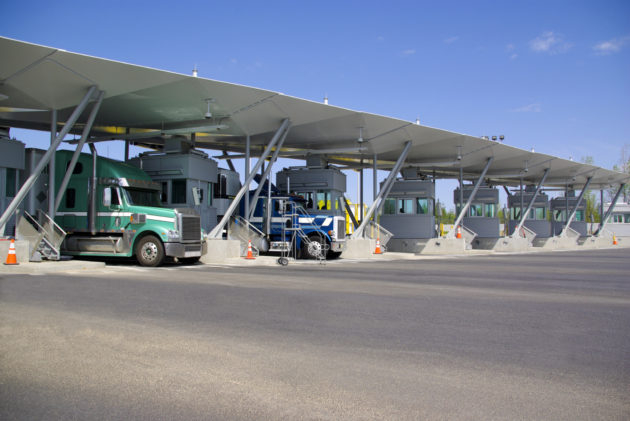Heavy-duty trucking has continued to drive forward during the Covid-19 crisis, operating at around 89% of its normal rate of activity, according to telematics data from Geotab, compared to 69% for passenger vehicles.
Considering the overall impact of Covid-19 on businesses and consumers across North America, the fact that trucking – considered to be an essential service – has only seen moderate declines, is somewhat of a surprise. Particularly when it comes to cross-border activity, which was closed down to all non-essential traffic March 21.
“With the shutdown of many non-essential businesses across North America and the unprecedented impact on the economy, we expected a stronger decline in cross-border traffic,” said Daniel J. Lewis, senior data scientist and research and development specialist for Geotab. “However, with the increase of demand for essential goods, such as toiletries and groceries, as well as the continued operation of home delivery services, there remains a strong demand for continued operation of the trucking supply chain.”
Geotab’a data shows that on average, the Canadian commercial transportation industry is operating at 79% of normal activity across all vehicle types since March 15. Similar to that of the U.S., which is at 82%.
“While many communities across North America and the world are declaring a state of emergency and are mandating the closure of non-essential businesses, trucking and logistics companies are continuing to deliver the goods that we rely on every single day,” said Neil Cawse, CEO of Geotab. “We at Geotab send our sincere gratitude to all truck drivers, along with health care workers, grocery store employees and many more who are continuing to provide the services and goods that we need.”
Canada’s Maritime provinces has seen the steepest decline in truck activity, operating at 69% of its normal commercial transportation levels. In the U.S., the states of New York and New Jersey, considered the North American epicenter of the coronavirus, is down to 63% compared to its normal activity.
It should come as no surprise that grocery store demand is the reason behind much of the continued need for trucking, accounting for 90% of the flow of commercial transportation activity according to data collected March 27.
By comparison, the movement of goods to most retail stores has declined anywhere from 20%-30%. Warehouse activity is holding steady at 82% of its normal rate, while industrial has seen a decline of 25%.
Lytx has also looked at its telematics data to determine the impact the Covid-19 response has had on trucking, and found the industry has seen an overall reduction in mileage and the number of trips.
Between March 1-22, mileage racked up by truck traffic was down 6%, and the number of trips fell by 1%.
General freight saw a 5% decline in mileage and 1% drop in the number of trips, while specialized freight was down 3% for the number of trips and 2% for miles traveled.
With passenger vehicle travel down due to stay-at-home requests from various provinces and states, trucking has also seen a reduction in interactions with other drivers on the road.
Lytx data reveals that collisions are down 28%, and near collisions, both avoidable and unavoidable, are down 25% and 23% respectively.
“These numbers are consistent with our expectations, both in terms of mileage, risk, and collisions, given the shutdown of non-essential businesses across the country,” said Kyle Warlick, client intelligence analyst for Lytx. “We know from both academic research, our own analyses of over the past several decades, and anecdotally from Lytx customers that driving risk is significantly heightened by the presence of other vehicles on the road, especially lower-volume or passenger vehicles.”
Warlick added that when it comes to the amount of mileage being driving by commercial trucks, the moderate drop shows how essential the industry is, even during a pandemic.
“More than anything,” he said, “we are grateful to these drivers for the hard work they are doing and excited to see so many other people realizing the importance of this industry and going out of their way to thank drivers for continuing to show up in this troubling time.”
Despite what have been mild to moderate declines in trucking activity, depending on the type of business being serviced, fuel purchases remain similar to post-Covid-19 totals.
Geotab data shows steep declines in fuel purchases for passenger vehicles, buses, and multipurpose vehicles, like vans, but holding steady for light-, medium-, and heavy-duty trucks.
At the Canada-U.S. border, truck volumes have dropped since early March, as have wait times.
Data collected at the Detroit-Windsor, Fort Erie, Queenston, and Sarnia ports of entry show a truck traffic decline of 30% between Feb. 1 and March 15.
“The volume reduction in cross-border truck movement is possibly due to the reduction of demand for non-essential goods,” said Lewis. “We are noticing what we think is a corresponding decrease in cross-border movement – which has been stabilizing over the past several days – and will continue to monitor this.
“Aside from national holidays such as Christmas, where we always see a reduction in cross-border travel, we have not seen a similar impact from any other events. The impact from holidays is only transient and we haven’t seen a sustained decrease like we see now.”


